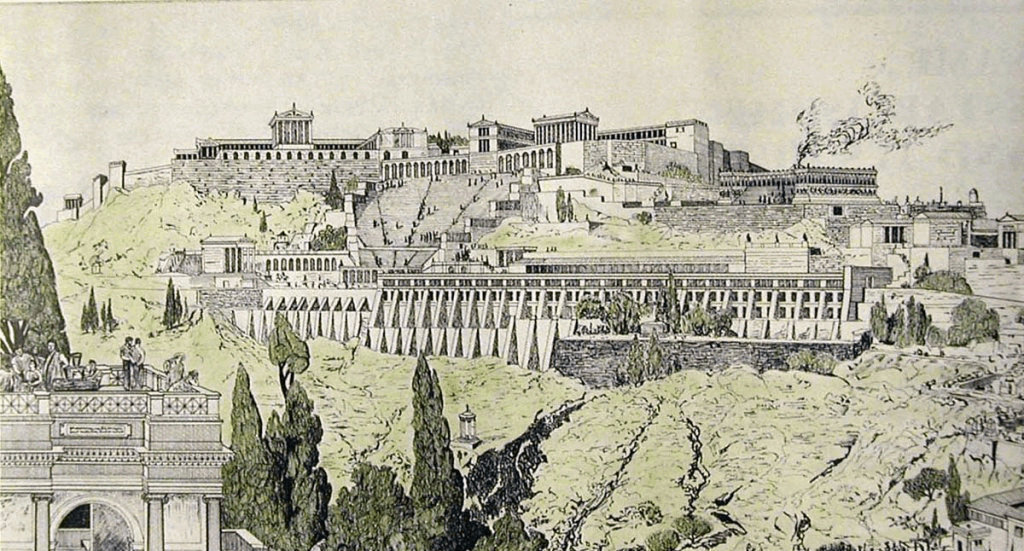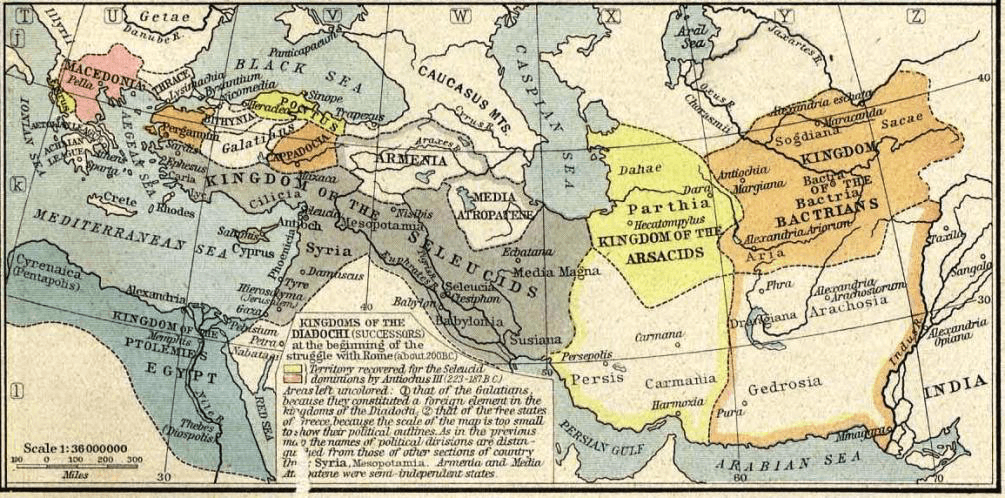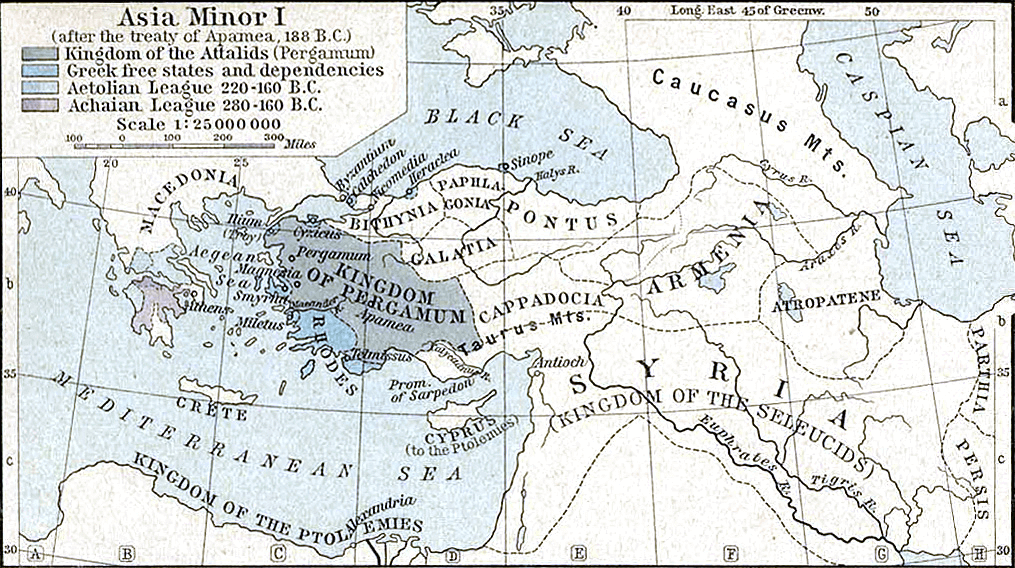Settlements > Pergamon
Pergamon
Background
The city of Pergamon, also called Pergamum was an ancient Greek city that was located in Anatolia or modern day Turkey. It is about 26 km (16 m) away from the Aegean Sea on the north side of the river Caicus. The city became famous during the Hellenistic Period under the Attalid Dynasty which ruled from 281 to 133 BCE. Under the Attalid Dynasty the famous Library of Pergamon was constructed which was to rival the famous Library of Alexandria.
Pergamon is mentioned during the Book of Revalation as one of the seven churches of Asia. After the leaders of its dynasty all died off without heirs the city was given to the Roman Empire where it later prospered under both the East and Western Roman Empires. It later became part of the Byzantine Empire and later the Ottoman Empire where a modern city was built right nearby.

Pergamon Reconstruction - 19th Century Germany Drawing
Overall the city and kingdom of Pergamon is very unique in the sense it was the first Greek city to switch sides and ally with the Romans.
Origins
The earliest accounts that survive of Pergamon date to the conquests of Xenophon. The city was captured in 399 by was soon recovered by the Achaemenid Empire. It would try to revolt during the Ionian Revolt in 362 BCE but this would be brutally put down by the Persians.
The city was most likely liberated from the Persians by Alexander the Great on his march through Asia Minor after winning the Battle of the Granicus. After Alexander the Great died suddenly and unexpectedly his empire fell apart and his successors and generals began to fight over his territory in what became known as the Wars of the Diadochi. In 301 BCE the city of Pergamon became territory under Lysimachus who was the king of Thrace.

Diadochi Kingdoms 301 BCE - Historical Atlas (1923)
The city was expanded under the rule of Lysimachus but soon the kingdom of Thrace collapsed and the city became the capital of a brand new kingdom. The officer involved in enlarging and maintaining Pergamon was named Philetaerus and upon the collapse of Thrace he assumed power and established the Attalid Dynasty in 218 BCE. In 261 BCE Philetaerus abdicated the throne and passed down rule to his nephew Eumenes II who ruled from 263 BCE to 241 BCE. He passed down rule to his cousin Attalus I who ruled from 241 to 197 BCE.
During this period the Pergamon kingdom actually affiliated with the Roman Republic. Under Attalus I and Eumenes II they actually participated in the Macedonian Wars allied against both Philip V and Perseus of Macedon respectively.

Diadochi Kingdoms 200 BCE - Historical Atlas (1923)
By aiding the Romans during this period the Attalid Dynasty was rewarded with all the previous Asia Minor territories of the Seleucid Empire. After 188 BCE the city of Pergamon rose in influence and power greatly. The city had stagnated in terms of development since first changing hands to Philetaerus but this was all to change soon.
Before 188 BCE the city covered around 21 hectares or 52 acres. Following that year a massive wall was constructed 4 km long (2.5 miles) that enclosed the new city which covered about 90 hectares or 220 acres. This is more than 4x the previous size of the city and launched the kingdom into a golden age and period of prosperity. The city of Pergamon was able to expand its influence throughout the region along with its global territory as well.

Asia Minor 188 BCE - Historical Atlas (1923)
In addition to expanding the city they built many great structures within that are mentioned later. The Attalid Dynasty was known to have been fair and just rulers who supported the growth of small towns and villages by sending them skilled workers and giving them early tax breaks. The Greek cities within their regional kingdom were allowed a degree of independence and they also sent many gifts to the prestigious Greek cities such as Delphi, Athens and Delos.
The Attalid Dynasty was also known to be great warriors and they managed to defeat invading Celts which would destroy most of the Roman Empire within a few hundred years. However, when King Attalus III who reigned from 138 BCE to 133 BCE died without an heir the entire kingdom was given to the Roman Empire in order to prevent a civil war over its future.
Roman Empire
Not everyone in Pergamon accepted Rome's rule. Aristonicus, who claimed to be Attalus' brother as well as the son of Eumenes II, an earlier king, led a revolt among the lower classes with the help of Blossius. The revolt was put down in 129 BC, and Pergamon was divided among Rome, Pontus, and Cappadocia. Pergamon was briefly the capital of the Roman province of Asia, before the capital was transferred to Ephesus.
After a slow decline, the city was favoured by several imperial initiatives under Hadrian (117 - 138). It was granted the title of metropolis and as a result of this an ambitious building programme was carried out: massive temples, a stadium, a theatre, a huge forum and an amphitheatre were constructed. In addition, at the city limits the shrine to Asclepius (the god of healing) was expanded into a lavish spa.
The Sanctuary of Asclepius grew in fame and was considered one of the most famous therapeutic and healing centers of the Roman world. Galen, after Hippocrates the most famous physician of antiquity, was born at Pergamon and received his early training at the Asclepeion. Pergamon reached the height of its greatness under Roman Imperial rule and was home to about 200,000 inhabitants. The Library of Pergamon was renowned, and second only to the Library of Alexandria, although not approaching Alexandria in scholarship.
The city was an early seat of Christianity and was granted a bishopric by the second century. Pergamon is mentioned in the Book of Revelation, as a dwelling place of Satan and a location of his throne, and that an early bishop named Antipas was martyred there. The city suffered badly during the third century and was badly damaged by an earthquake in 262 and was sacked by the Goths shortly after. Anatolia was invaded by the Persian Sassanid Empire in c.620 and after the Persians were driven out by Byzantine forces, Pergamon was rebuilt on a much smaller scale by Emperor Constans II. Pergamon was sacked by the armies of Maslama ibn Abd al-Malik on their way to the siege of Constantinople in 717.
City Structures
Library of Pergamon
Pergamon Altar
The Great Altar of Pergamon is in the Pergamon Museum, Berlin. The base of this altar remains on the upper part of the Acropolis. It was perhaps this altar, believed to be dedicated to Zeus, that John of Patmos referred to as "Satan's Throne" in his Book of Revelation (Revelation 2:13). A smaller frieze on a wall inside the Altar of Pergamon depicted the life of Telephus, son of Heracles and legendary founder of Pergamon.
Other Acropolis Structures
Other notable structures still in existence on the upper part of the Acropolis include:
Upper Acropolis
The Hellenistic Theater with a seating capacity of 10,000. This had the steepest seating of any known theater in the ancient world.The Sanctuary of Trajan (also known as the Trajaneum)The Sanctuary of AthenaThe Library of PergamumThe Royal palacesThe Heroön – a shrine where the kings of Pergamon, particularly Attalus I and Eumenes II, were worshipped.The Temple of DionysusThe Upper AgoraThe Roman baths complexDiodorus Pasporos heroonArsenals
The site is today easily accessible by the Bergama Acropolis Gondola from the base station in northeastern Bergama.
Lower Acropolis
The lower part of the Acropolis has the following structures:
the Upper Gymnasiumthe Middle Gymnasiumthe Lower Gymnasiumthe Temple of Demeterthe Sanctuary of Herathe House of Attalusthe Lower Agora andthe Gate of Eumenes
Acropolis Base
Sanctuary of Asclepius: Three kilometers south of the Acropolis at (39 7' 9" N, 27 9' 56" E), down in the valley, there was the Sanctuary of Asclepius (also known as the Asclepium), the god of healing. The Ascelpium was approached along an 820 meter colonnaded sacred way. In this place people with health problems could bathe in the water of the sacred spring, and in the patients' dreams Asclepius would appear in a vision to tell them how to cure their illness. Archeology has found lots of gifts and dedications that people would make afterwards, such as small terracotta body parts, no doubt representing what had been healed. Galen, the most famous doctor in the ancient Roman Empire and personal physician of Emperor Marcus Aurelius, worked in the Ascelpium for many years. Notable extant structures in the Asclepium include:
the Roman theaterthe North Stoathe South Stoathe Temple of Asclepiusa circular treatment center (sometimes known as the Temple of Telesphorus)a healing springan underground passagewaya librarythe Via Tecta (or the Sacred Way, which is a colonnaded street leading to the sanctuary) anda propylon
Serapis Temple
Pergamon's other notable structure is the great temple of the Egyptian gods Isis and/or Serapis, known today as the "Red Basilica" (or Kızıl Avlu in Turkish), about one kilometer south of the Acropolis at (39 7' 19" N, 27 11' 1" E). It consists of a main building and two round towers within an enormous temenos or sacred area. The temple towers flanking the main building had courtyards with pools used for ablutions at each end, flanked by stoas on three sides. At this temple in the year 92 Saint Antipas, the first bishop of Pergamum ordained by John the Apostle, was a victim of an early clash between Serapis worshipers and Christians. An angry mob is said to have burned Saint Antipas alive inside a Brazen Bull incense burner, which represented the bull god Apis. In the 1st century AD, the Christian Church at Pergamon inside the main building of the Red Basilica was one of the Seven Churches to which the Book of Revelation was addressed. Revelation 2:12. The forecourt is still supported by the 193 m wide Pergamon Bridge, the largest bridge substruction of antiquity.
Famous People
- 200 BCE - Epigonus (Sculptor)
- 100 BCE - Sosus of Pergamon (Mosaic Artist)
- 200 CE - Aelius Nicon (Architect & Engineer)
- 129–200/216 AD - Galen (Physician)
Sources
- Abila
- Adramyttion
- Ahsiket
- Akanthos
- Aleppo
- Alexandria Ad Issum
- Alexandria Arachosia
- Alexandria Ariana
- Alexandria Asiana
- Alexandria Bucephalous
- Alexandria By The Latmus
- Alexandria Eschate
- Alexandria In Carmania
- Alexandria In Egypt
- Alexandria In Makarene
- Alexandria In Margiana
- Alexandria In Opiana
- Alexandria In Orietai
- Alexandria In Susiana
- Alexandria Near Issus
- Alexandria Niceae
- Alexandria On The Caucasus
- Alexandria On The Hyphasis
- Alexandria On The Indus
- Alexandria On The Oxus
- Alexandria Prophthasia
- Alexandria Rhambacia
- Alexandria Tarmita
- Alexandria Troas
- Alexandria
- Alexandrian Settlements
- Alexandrupolis
- Alinda
- Amaseia
- Amorium
- Amphipolis
- Amyzon
- Anatolian Settlements
- Ancoz
- Anthemusias
- Antigonia Chaonia
- Antigonia In Paeonia
- Antigonia In Syria
- Antigonia Psaphara
- Antigonid Settlements
- Antioch Epidaphne
- Antioch Of Hippos
- Antioch Of Pisidia
- Antioch On The Golden River
- Antioch On The Maeander
- Antioch On The Orontes
- Antioch
- Antiochia Ad Cragum
- Antiochia Ad Pyramum
- Antiochia Ad Taurum
- Antiochia In Cilicia
- Antiochia In Lydia
- Antiochia In Mesopotamia
- Antiochia In Scythia
- Antiochia In Sittacene
- Antiochia In Susiana
- Antiochia Lamotis
- Antiochia Mygdonia
- Antiochia Of Chosroes
- Antiochia Of The Chrysaorians
- Antiochia On The Callirhoe
- Antiochia On The Cydnus
- Antiochia On The Taurus
- Antiochia Paraliou
- Antipatrid Settlements
- Apamea Cibotus
- Apamea In Babylonia
- Apamea In Media
- Apamea In Sittacene
- Apamea In Syria
- Apamea Myrlea
- Apamea On The Euphrates
- Apamea Ragiana
- Apollonia
- Arbela
- Aretas IV Philopatris
- Arg E Bam
- Argead Settlements
- Argos
- Arigaeum
- Arsameia
- Arsamosata
- Arsinoe Epidires
- Arsinoe In Cilicia
- Arsinoe In Crete
- Arsinoe In Northwest Cyprus
- Arsinoe In Southwest Cyprus
- Arsinoites
- Artemita In Apolloniatis
- Ashkelon
- Asian Settlements
- Astacus In Bithynia
- Aswan
- Asyut
- Athens
- Attalea
- Attalid Settlements
- Ay Khanum
- Baalbek
- Babylon
- Bactra
- Bactrian Settlements
- Balasagun
- Barbarikon
- Bellegrada
- Berenice Epideires
- Berenice Panchrysos
- Berenice Troglodytica
- Berenike
- Birtha
- Bithynian Settlements
- Blaundos
- Bolbitine
- Borsippa
- Buto
- Byblos
- Byzantium
- Canopus
- Carian Settlements
- Carthage
- Cassandreia
- Cebrene
- Chalcedon
- Cius
- Corinth
- Corycus
- Ctesiphon
- Cyrene
- Cyropolis
- Cyrrhus
- Cyzicus
- Dalverzin Tepe
- Damascus
- Daphne
- Dascylium
- Dathema
- Decapolis
- Delos
- Delphi
- Demetriapolis
- Demetrias In Assyria
- Demetrias
- Diadochoupolis
- Dion
- Docimium
- Dumatha
- Ecbatana
- Edessa
- Egyptian Settlements
- Ekron
- Elaea Lebanon
- Elaea
- Emirzeli
- Ephesus
- Epirote Settlements
- Eshnunna
- Eucratideia
- European Settlements
- Gabai
- Gamla
- Gath
- Gaza
- Gazoros
- Gerrha
- Giza
- Gordium
- Greek Settlements
- Halicarnassus
- Harran
- Hegra
- Hekatompylos
- Heliopolis
- Hellenistic Colonies
- Hellenopolis
- Heraclea Lyncestis
- Heraclea Pontica
- Heraclea Sintica
- Heraclea
- Hierapolis
- Ikaros
- Indian Settlements
- Indo Greek Settlements
- Issus
- Jerusalem
- Kale Krsevica
- Kalindoia
- Kandyba
- Knidos
- Komopolis
- Konope
- Kos
- Lagina
- Lamia
- Lampsacus
- Laodicea Ad Libanum
- Laodicea Combusta
- Laodicea Pontica
- Laodicea
- Laodiceia
- Leuke Kome
- Lysimachia
- Lysimachian Settlements
- Macedonian Settlements
- Magnesia Ad Sipylum
- Maracanda
- Marathon
- Mathura
- Mediterranean Settlements
- Megara Hyblaea
- Megara
- Memphis
- Merv
- Mesopotamian Settlements
- Metropolis
- Milas
- Miletus
- Myos Hormos
- Myra
- Mysomakedones
- Negotino
- Nicaea And Bucephala
- Nicaea
- Niya
- Nysa On The Maeander
- Olympia
- Olympos
- Olynthus
- Ouranoupoli
- Palmyra
- Paneas
- Paroecopolis
- Pasargadae
- Patala
- Pataliputra
- Pelium
- Pella
- Pelusium
- Pentapolis
- Pergamon
- Perseis
- Persepolis
- Persian Settlements
- Petra
- Peucela
- Phasaelis
- Phaselis
- Phila
- Philadelphia
- Philippopolis
- Phoenician Settlements
- Phthiotic Thebes
- Plataea
- Prophthasia In Drangiana
- Prusa
- Pteria
- Ptolemaic Settlements
- Ptolemais Hermiou
- Ptolemais Theron
- Ptolemais
- Pythion
- Qalatga Darband
- Raphia
- Rhacotis
- Rhambacia
- Rhinocorura
- Rhodes
- Rome
- Sagala
- Sagalassos
- Saketa
- Saksanokhur
- Samosata
- Sardis
- Seleucia Ad Belum
- Seleucia At The Zeugma
- Seleucia In Sittacene
- Seleucia On The Calycadnus
- Seleucia On The Hedyphon
- Seleucia On Tigris
- Seleucia Pamphylia
- Seleucia Pieria
- Seleucia Samulias
- Seleucia Sidera
- Seleucia
- Seleucid Settlements
- Serraepolis
- Sialkot
- Side
- Sidon
- Sirkap
- Siwa Oasis
- Smyrna
- Soli
- Sparta
- Stratonicea In Caria
- Stratonicea In Lydia
- Stratonicea
- Sulusaray
- Susa
- Syracuse
- Syrian Tetropolis
- Taposiris Magna
- Tarsus
- Taxila
- Tel Anafa
- Termessos
- Thapsacus
- Tharros
- Thebes Egypt
- Thebes Greece
- Therma
- Thermos
- Thessaloniki
- Thmuis
- Troy
- Tyre
- Uranopolis
- Xanthos
- Yerevan
- Zeugma